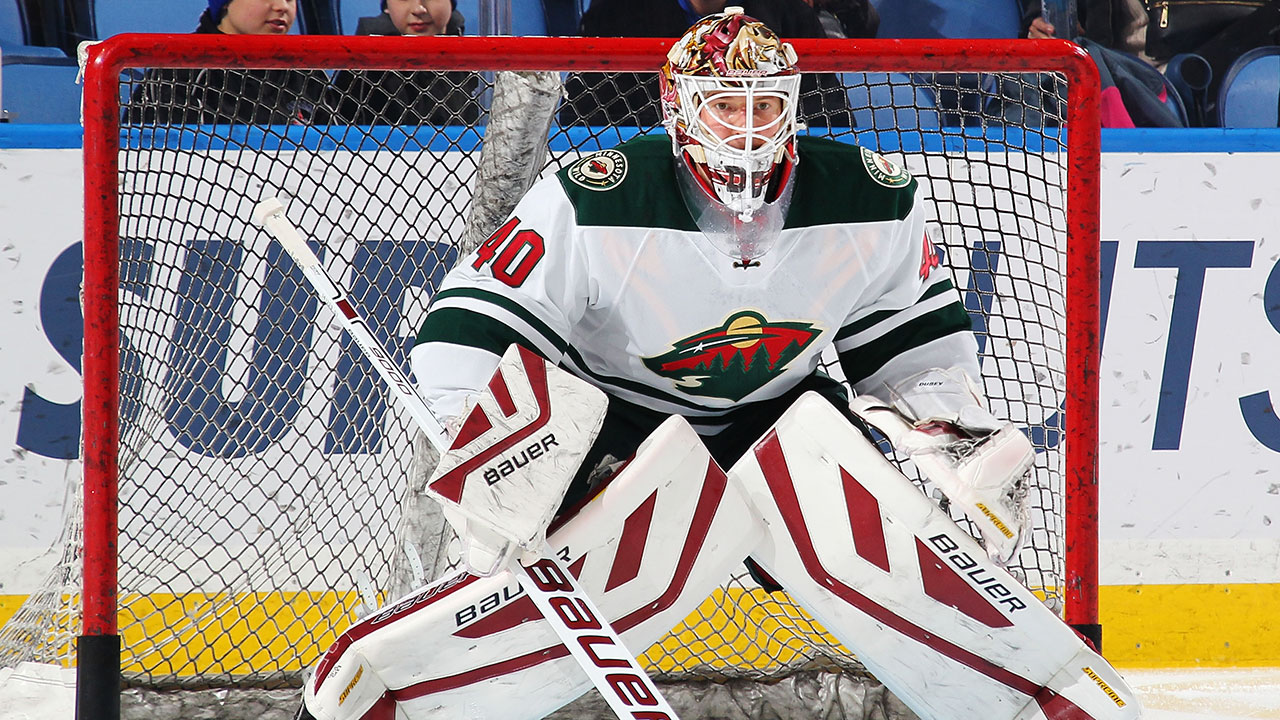Amid rampant speculation the Minnesota Wild were on the brink of firing head coach Mike Yeo, GM Chuck Fletcher instead opted to throw his coach a lifeline in the form of a new goaltender. That goalie, Devan Dubnyk, was acquired on Wednesday in exchange for a third-round draft pick and the hope is that he can solidify what has been a position of considerable weakness for the Wild in 2014-15. He looked the part Thursday in a 7-0 shutout win over the Buffalo Sabres.
The first and most obvious question to ask about the deal is whether or not Dubnyk is good enough to make any kind of difference as the team’s No. 1 goaltender. After all, he had to settle for a one-year, $800,000 contract and a backup position in free agency this year after a 2013-14 campaign in which he struggled for three different teams, one of which was an AHL club.
Without a crystal ball it’s impossible to know the answer to that question for certain, but it’s worth pointing out that the last team to gamble on Dubnyk didn’t do too badly. Arizona GM Don Maloney made a small bet (by NHL standards) that Dubnyk’s long-term track record should be weighed more heavily than his struggles last season, and for his troubles he got 20 games of good goaltending and a third-round draft pick. That’s textbook asset management, as is trading him away right now—a move which allows the floundering Coyotes to play Mike Smith a lot and either salvage their No. 1 goalie or push hard for 30th overall and a favourable draft position.
It’s easy to see why Maloney would be impressed by the long-term track record. Dubnyk had played 30-plus games for the Edmonton Oilers in each season between 2010 and ’14, and in three of those four campaigns he’d posted an even-strength save percentage better than .920, the league average. Nobody would make the claim that his totals were being artificially inflated by Edmonton’s formidable defensive personnel or impeccable attention to detail in its own end of the rink. To paraphrase an old line: If a goalie can make it behind the Oilers’ defence, he can make it anywhere.
Minnesota’s gamble is even safer in that it comes with some additional evidence. Over 19 games for the Coyotes this season, Dubnyk managed a 0.932 even-strength save percentage. Arizona is known as a tight defensive team and many have suggested the Coyotes’ system makes goaltenders, but Dubnyk’s .932 comes in the same season that Smith is plodding along at 0.890. In other words, not only does Dubnyk have a decent long-term track record, but his recent work is exceptional.
That kind of goaltending performance is something the Wild desperately need. No team in the NHL has a worse even-strength save percentage this season than Minnesota’s .898. Darcy Kuemper has been flat-out bad with a .906 save percentage at evens (after recording a .932 in 20-odd games last season) and he’s been miles better than 36-year-old Niklas Backstrom, who’s been deteriorating steadily for three seasons now and could well be finished as an NHL-calibre option.
How much difference would Dubnyk make? For the sake of argument, let’s assume that if he had played for the Wild this season he would have provided the team with NHL-average goaltending (a 12-point drop from what he’s done in Arizona this year) and that he would have played the same 28 games that Kuemper has played (naturally, Dubnyk would have played more than that if he was performing well and everyone else was struggling). At even-strength alone, even with our cautious parameters, that would have improved the Wild by eight goals.
If we alter those parameters slightly, the change gets even bigger. We’ll leave Dubnyk with a .920 save percentage (that’s what his long-term track record suggests, and with goalies the long-term track record is the closest thing we have to Gospel) but what happens if we have him face three-quarters of the shots and have the best of Minnesota’s current goalies (Kuemper) face the other quarter? At even-strength alone the Wild would be 18 goals better than they have been this season. That’s almost a goal every other game, and given that Minnesota is minus-15 on the year it’s almost certainly enough to move the team from where it is currently (eight points back) right up to the playoff bubble.
But all of that is hypothetical; this trade doesn’t change the past and Minnesota’s patience with Kuemper and Backstrom is likely to doom it to an early summer. A playoff-bubble type performance the rest of the way won’t get the Wild into the post-season; as of this writing the cutoff for a playoff spot in the West looks to be in the 93-94 point range which means Minnesota needs to go something like 23-11-5 the rest of the way. There’s a chance that happens, particularly if Dubnyk keeps rolling along with a .932 even-strength save percentage and if the competition brings out the best in Kuemper, but it’s not a great chance. More likely, this is the kind of trade that will position the Wild for next year, allowing them to give Dubnyk a test run and maybe to keep Yeo on as head coach.
It’s a good deal for the Wild. It really didn’t cost much to add Dubnyk and Minnesota is a team that should be doing all it can to win as soon as possible. The only question is why it took so long for this trade to get made.

